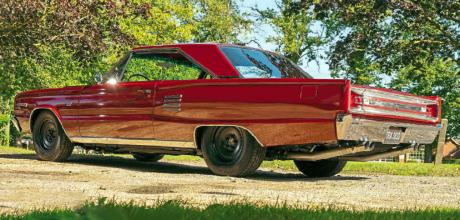1966 Dodge Coronet 500
Clothing Vince Donald’s 1966 Dodge Coronet 500 now sports upgraded suspension and a big-block race Hemi, yet on the outside it still looks just like it did the day he bought it…
WOLF in WOLF’S Clothing
Photography: Matt Richardson
Words: Mike Renaut
Should there ever be a gameshow where contestants must guess which owner goes with which car, Vince Donald would have a great chance of winning. Few might expect this modest, quietly spoken retired computer engineer to be driving a race-inspired 1966 Dodge Coronet 500 with a Keith Black Hemi under the bonnet. An engine, incidentally, which Vince built himself.
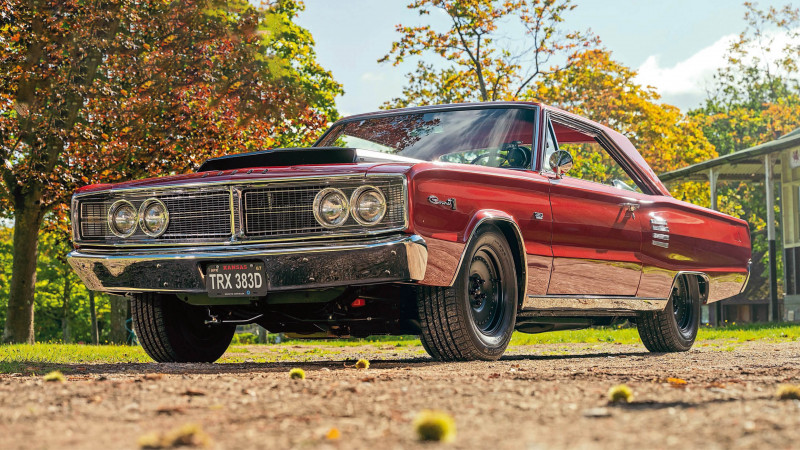
“I saw the Dodge advertised online in 2005 and flew over to Canton, Ohio, to see it,” explains Vince. “It was the right colour and specification, so after agreeing the price I had it shipped back to the UK. I prefer to see cars in person first for peace of mind. That way there are no surprises when they arrive and you suddenly realise you’ve bought a sedan not a coupe, or it has unseen rot that wasn’t apparent in the photos. I already had a 1969½ Six Pack Super Bee I’d owned for 16 years and I only sold that to force me to concentrate on the 500 otherwise, at the pace I work, it would never have been finished.
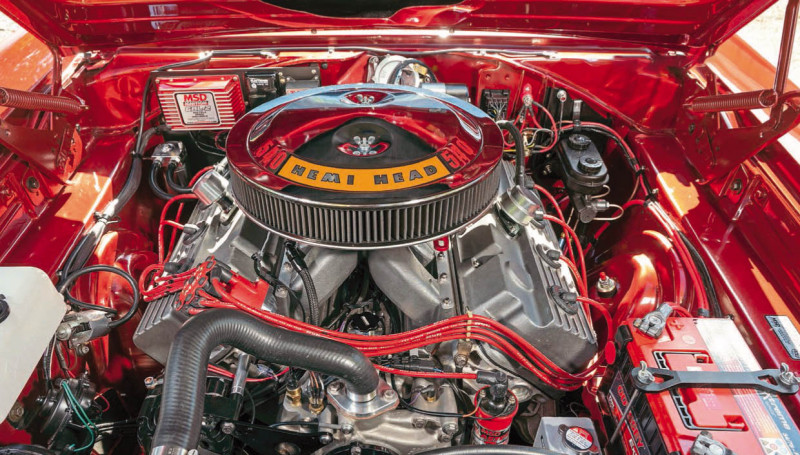
“Before the Super Bee, I’d had a 1969 Charger – that one was a genuine Hemi four-speed car. I bought it in 1981 when they were just about still affordable. It’s still around; I think it went to Jersey. Having owned both kinds, I prefer a TorqueFlite car to a four-speed.” Although the TorqueFlite-equipped Coronet 500 was in totally original, numbers-matching condition, it wouldn’t stay that way for long. “I wanted to increase the performance, but to a point where I could still handle it safely,” explains Vince. “That meant working on virtually every aspect of the car except the bodywork.
That side of things only needed a clean and polish − I’d bought this car particularly because there was no rust and the paint looked great. But driving it back home from the docks I found that, despite being powered drums all round, the brakes were lethal – they were basically fully on or off. It had power steering too, but I didn’t like the lack of feel in it, so knew I’d be converting both steering and brakes to manual. The front drums were replaced with 12-inch police discs and calipers and I changed it from single to dual circuit, using a later model aluminium master cylinder and all new lines and prop valve.”
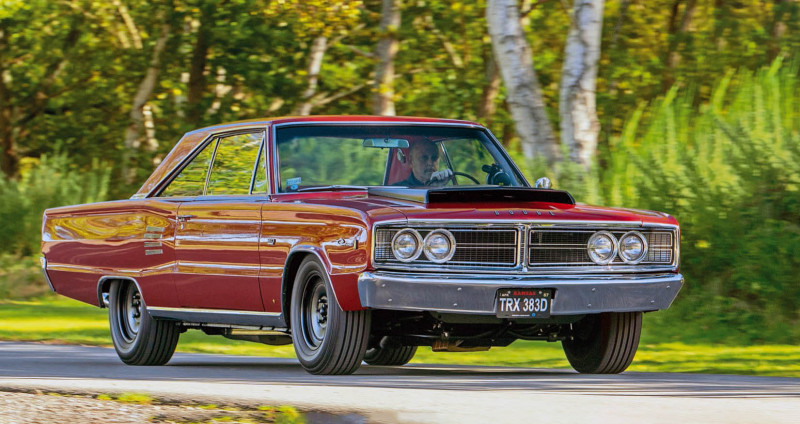
The reasoning behind the upgrade was that Vince had that Hemi engine to install. “The Coronet left the factory as a 383cu in V8, but I’ve replaced that with a Keith Black 541cu in Hemi street block. I sourced most of the main parts from fellow Mopar Muscle Association UK (www.moparuk.com) member Pete Wiseman, then built it up myself. It’s the second time I’ve done a complete engine build, although first I still read up on all the do’s and don’ts for Hemis. It has Edelbrock heads, Crower solid roller cam, JE Pistons and 12:1 compression, Eagle 7:1 rods and 4.5-inch crank, plus a complete rocker shaft stand setup from FHO. The carb is a Quick Fuel 950cfm 4150 sitting on an ICH single plane intake manifold. There’s dual Spal electric fans, electric fuel and water pumps and MSD ignition, while a Griffin Performance aluminium radiator keeps temperatures under control.”
Automatic choice
Bolted behind the Hemi is a three-speed TorqueFlite from A&A Trans in Camby, Indiana, boasting all new internals including a steel front drum, Super Sprag and reverse pattern manual valve body with low band apply. Vince treated his Coronet to upgraded suspension too: “New Hemi springs, Fox aluminium shocks, torsion bars, sway bar and Hotchkis subframe connectors. The K-member seams were reinforced and a skid plate fitted. Schumacher poly spool mounts hold the motor in place. There’s a Denny’s ally drive shaft with 1350 joints, while the rear axle is a Moser Trac-Lok Dana 60 with 3:54 gears.” Gases exit through a three-inch TTI H-pipe exhaust system with internally ceramic-coated two and one-eighth headers and DynoMax Super Turbo mufflers.
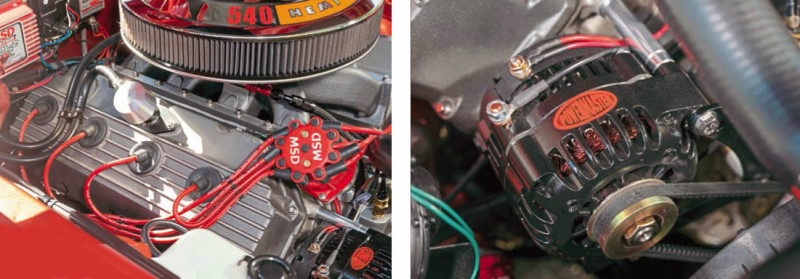
Although the interior appears largely original, in reality it’s been completely retrimmed in the factory style and colour of vinyl. “I put in new door cards, seat covers, parcel shelf and modified the centre console for the B&M ratchet shifter. There’s a few extra gauges in there too.” The Coronet was originally an air-conditioned car, but that was removed along with the heater. “You couldn’t get factory A/C on a Hemi Coronet anyway,” adds Vince, “there wasn’t enough space under the bonnet.”
Speaking of which: “It came with the standard flat bonnet, but due to air cleaner size and it sitting higher, I added an AAR glass fibre hood together with a WO23 style scoop.”
The Coronet badge was first bolted on to a Dodge in 1949 and at that time it denoted the division’s highest trim level. Back then, Dodges were solid and dependable, if somewhat mundane, everyday cars. But from 1953 came the option of a 241cu in Red Ram Hemi V8 which introduced a little excitement, and within two years Dodge was combining good performance with enticing new styling. The Dodge Royal became top dog in 1954. For 1955, Coronet was now the base model and remained that way until 1959 when the series was dropped. Then in 1965 Dodge reintroduced its Coronet nameplate with the B-body as an intermediate-size car built on a 117-inch wheelbase, which made it slightly larger than the rival Chevelle or Fairlane.
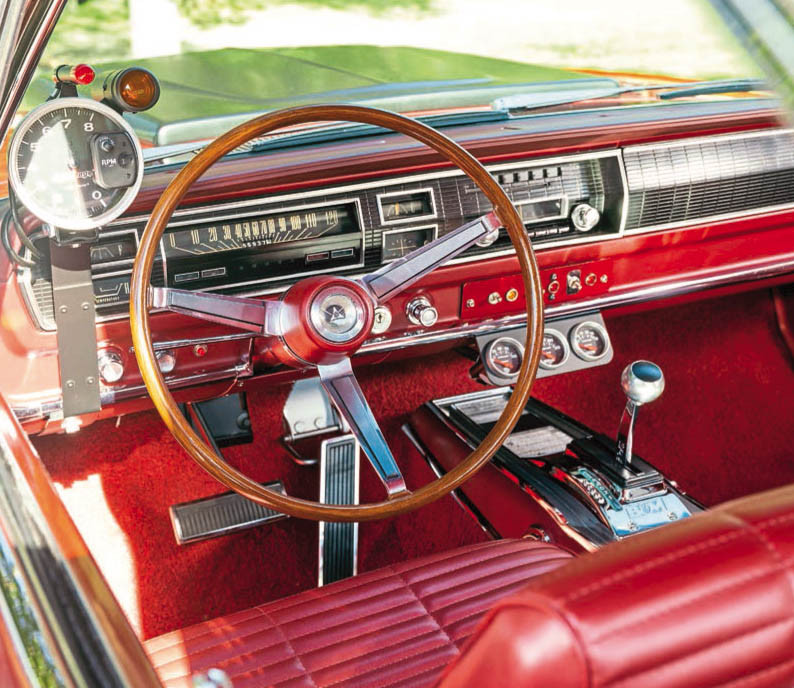
For 1966, Dodge’s car production totalled 532,026 units, which maintained Dodge’s place as seventh-best seller in America. Coronet remained the intermediate-size model above the compact Dart, alongside the brand new sporty and Coronet-based Charger and below the fullsize Polara and Monaco series. The Coronet got a complete restyle for ’66 and was slightly wider, yet just under an inch shorter than the 1965 models. Immediately identifiable by their deltashaped tail-lights, the Coronets were available in four sub-series as Coronet, a new Coronet Deluxe, Coronet 440 or Coronet 500 in two- and four-door sedans and a four-door wagon. There was additionally a convertible in the 440 and 500 range, although a 500 wagon wouldn’t be available until 1968.
Also new for 1966 was a four-door 500 called the 500 SE that denoted it as a Special Edition. As top trim level model, the 500 got the plushest trim including four chrome louvre-style trims on the rear quarter and 500 badging.
Elephant in the engine room
Base engine for the four-door sedan was a 225cu in slant six, while the others started with the 273cu in V8. Optional powerplants were the 383 or even the formidable 426 Hemi. In theory, the 426 Street Hemi could be fitted to any Coronet and at least two of the 136 Street Hemis built for 1966 did indeed find their way into four-door sedans. A three-speed manual transmission was standard, with three-speed TorqueFlite automatic and four-speed manual ’boxes as options. A Coronet 500 two-door hardtop like our feature car would have had a base price, before options, of $2705 and weighed 3275lb. Individual body style sales weren’t recorded, but we know Coronet 500 production was 55,700 units for 1966, of which all but 500 were V8s.
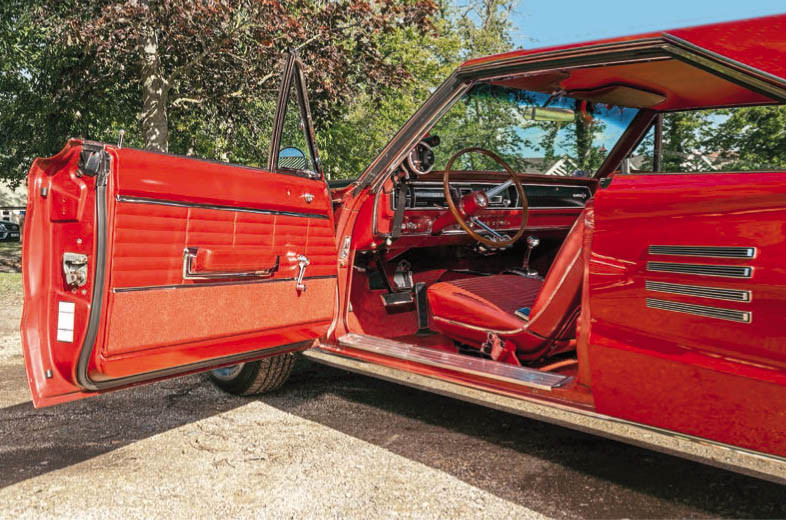
Sadly, Vince got no information about his Coronet’s past when he bought it, other than that the previous owner kept it in a heated garage and it shows 54,000 miles.
“I know the Coronet was last painted in America in 2001 and that’s lasted very well, only needing a polish.” Those decals on the Dodge’s screen say Sedgwick County, Kansas and are dated 2017 but, hang on, didn’t Vince say he bought the car in Ohio? And in 2005? Turns out Vince printed the decals and added them himself, just like those 1967-dated number plates, simply because he liked the look. You might not think any Hemi Coronet could be described as ‘subtle’, but Vince says that explains his wheel choice of those powder-coated, satin black Centreline Auto Drag wheels measuring 7x15 and wrapped in 235/15 Continental tyres. “My Super Bee had gloss black steel wheels when it left the factory; they just give the car an understated look.”
So there were no regrets about changing such an original car? “No, they made thousands of them so it’s not like I’ve messed with a rare car,” reasons Vince. “The Coronet was my exercise in taking a solid original, nice car and doing it my way. I can’t paint or weld well enough to tackle a project car so I needed that good base to start with. I wanted to put my mark on it and I’ve done pretty much all the work myself. It’s been an all-consuming labour of love; actually driving it is just a bonus. I’ve never raced the Coronet, it’s just a quick road car. Though I tell people this is a hybrid; it burns both gas and rubber!”
Satin black Centreline Auto Drag wheels look tough. Interior was retrimmed. 383… just kiddin’… AAR glass fibre hood. Mmmm… That C-pillar. Coronet 500 production was 55,700 units for 1966.Rear lights were super simple.
Vince has created Mopar heaven on wheels. Engine boasts Edelbrock heads, Crower solid roller cam, JE Pistons and 12:1 compression. … except for that tach. Dash is mostly stock… Mopar man: Vince Donald.


